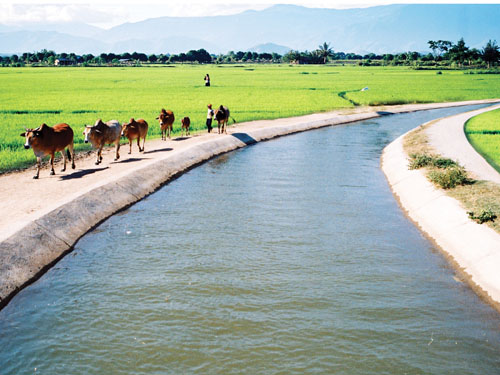Measures for Energy Conservation in the Field of Irrigation
This is an important content stipulated in Circular 19/2013/TT-BNNPTNT issued by the Ministry of Agriculture and Rural Development, guiding measures for the economical and efficient use of energy in agricultural production.
In the work of planning, water use, and operation of the irrigation system, organizations, households, and individuals should implement energy-saving measures and use energy efficiently according to the guidance in Circular 19/2013/TT-BNNPTNT, specifically:

Illustration (source: Internet)
Firstly, in planning work: Organize the planning of a reasonable irrigation system; prioritize solutions for gravity-fed irrigation and drainage; prioritize the construction of closed water conduits to replace open trapezoidal channels to reduce water consumption and land occupation; gradually replace traditional surface flooding irrigation with more water-saving irrigation methods (sprinkler irrigation, mist irrigation, drip irrigation, root soaking, etc.);
Secondly, save and use water efficiently:
- Check and assess the weather conditions, water source status (rainfall, reservoirs, rivers, saltwater intrusion, etc.) to develop a water use plan balanced with the water source capacity.- Apply scientific water-saving irrigation methods, implement the policy of “field consolidation and exchange,” and level the field surface.- Organize the dredging of the water intake works and supply channels; clean up water hyacinths, trash, clear the flow, remove obstructions and obstacles in the water conduits, water intake culverts, and pump station intake basins; plan reasonable water drainage to prevent waterlogging.
Thirdly, operate the irrigation system appropriately for each type of work:
- For gravity-fed systems (reservoirs, dams, sluices, etc.): develop a plan and proactively cooperate with relevant units to manage the operation of reservoirs and water supply for production at the right time; strictly implement water alternation on canal routes; inspect and repair field and plot banks to prevent water leakage through canal banks, sluice gates, and valves.- For the Mekong Delta area: gradually complete the system of embankments, field and plot banks, sluices, and dams to ensure proactive water intake and discharge to effectively exploit the integrated benefits during flood arrival and recession.- Electric pumping stations: establish a water pumping schedule, ensuring the synchronized operation of the entire system between small and large pumping stations; regularly monitor water levels, take advantage of off-peak hours for pumping to utilize the power grid and save electricity.- Plan to gradually replace outdated, low-efficiency pumps and electric motors with new, high-efficiency ones.- For tidal areas: carry out measurements and monitoring of saltwater intrusion at sluice gates and pump station intake basins to maximize the pumping system's capacity when conditions allow.
More details can be found in Circular 19/2013/TT-BNNPTNT, effective from May 1, 2013.
Thu Ba
- Number of deputy directors of departments in Vietnam in accordance with Decree 45/2025/ND-CP
- Cases ineligible for pardon in Vietnam in 2025
- Decree 50/2025 amending Decree 151/2017 on the management of public assets in Vietnam
- Circular 07/2025 amending Circular 02/2022 on the Law on Environmental Protection in Vietnam
- Adjustment to the organizational structure of the Ministry of Health of Vietnam: Certain agencies are no longer listed in the organizational structure
- Vietnam aims to welcome 22-23 million international tourists in Vietnam in 2025
-

- Notable new policies of Vietnam effective as of ...
- 16:26, 11/04/2025
-
.Medium.png)
- Notable documents of Vietnam in the previous week ...
- 16:21, 11/04/2025
-
.Medium.png)
- Notable documents of Vietnam in the previous week ...
- 16:11, 02/04/2025
-
.Medium.png)
- Notable new policies of Vietnam to be effective ...
- 16:04, 02/04/2025
-
.Medium.png)
- Notable new policies of Vietnam effective from ...
- 14:51, 21/03/2025
 Article table of contents
Article table of contents
